Saturday, August 9, 2025
Sunday, June 15, 2025
A Tribute to Don Garber of Fi + Robin and Lipman!
My first exposure to Don Garber's Fi 2A3 amp was at a gathering of burgeoning SE-DHT/High Efficiency speaker enthusiasts organized by Mike LaFevre of Magnequest and Peter Breuninger, then president of the Philadelphia Audio Society. This was held in the outskirts of Philly during the latter part of 1994. I attended to assist my friend Steve Melkisethian in exhibiting the Audio Note Kit 1 amplifier since he was the US distributor of Audio Note UK Kits, transformers and parts at that time. Sadly, these guys are no longer with us. 😔
Saturday, March 8, 2025
Monday, July 8, 2024
AliEx amorphous, Hashimoto HL20K6 + Sony TamRadio line output transformers
 |
| L>R: 6AH4 + AliEx, 12B4A + Sony/Tamradio and 6AH4 + Hashimoto HL20K6 |
Thursday, February 22, 2024
SE171A Amp Remastered
My dad would've turned 97 today. To celebrate his birthday, the video clip above features a recording of his favorite violinist, Nathan Milstein, playing Presto from Bach's Sonata No. 1 in G minor for unaccompanied violin. While he was doing post-graduate studies at The Juilliard School in the mid 50s, he was fortunate to have attended concerts of the great violin virtuosos of that era - Jascha Heifetz, David Oistrakh, Nathan Milstein, etc.
He would later recount that Nathan Milstein's performance of the Glazunov violin concerto was the most unforgettable! Even if he never got a chance to add this violin concerto to his repertoire, he conducted the Manila Chamber Orchestra with me playing the Glazunov violin concerto in 1987. The music of the slide clip above is the middle movement from our performance.
Before I bore everyone reminiscing about my dad and our life as musicians, let's get on with the subject at hand. The amp featured in this upload uses a directly heated triode power tube that was introduced around the time my dad was born.
Friday, October 6, 2023
JE Labs Choke-Capacitance Coupled SE2A3 amp
 |
| Canon P + Canon 50mm f1.8 LTM Foma 100 in Rodinal |
Inspired by my plate choke-loaded 76 line stage preamp adventures, I was curious how a similar driver circuit configuration would sound in an SE2A3 amp. So I pulled out my Radiotron Designer's Handbook, 3rd Edition to gain a better understanding of choke-capacitance coupling (aka plate choke loading) vis-à-vis resistance coupling.
Below are highlights of relevant information I gathered.
Saturday, June 5, 2021
morrison micro 2A3, reimagined + Kasuga Wireless KA6625ST output transformer
Joe Roberts' piece, "I Never Met a 2A3 Amp That I Didn't Like," from Sound Practices Issue 15, is very persuasive. I built jc morrison’s micro 2A3 amp soon after I received the issue via snail mail fresh from the printers in the mid '90s. After rereading the article in ‘07, I got inspired to make a Radiotron SE2A3 variant.
Monday, July 1, 2019
Wednesday, April 17, 2019
Hashimoto H-203S from Kasuga Wireless
 |
| Kasuga Wireless |
 |
| Hashimoto H-203S |
Testing
 |
| 100Hz |
 |
| 1kHz |
 |
| 10kHz |
 |
| 5.324Vrms to an 8 ohm load = 3.5W |
Thursday, December 20, 2018
Tuesday, September 11, 2018
Friday, July 28, 2017
Noguchi Finemet: FM-3WS-H + FM-6WS output transformers
This was the last extensive testing and listening session I did in the attic before we moved back to the states. I misplaced some data and just recovered them recently. So as promised in a previous blog entry, here's the write-up on the two entry-level SE Finemet OPTs from Noguchi.
WARNING
These are bonsai-sized output transformers. If HUGE iron + HIGH inductance and thumping bass frequencies is your idea of high-fidelity you should STOP 🛑 here!😉Noguchi FM-3WS-H
 |
| Noguchi FM-3WS-H + Tamura F7004 |
















